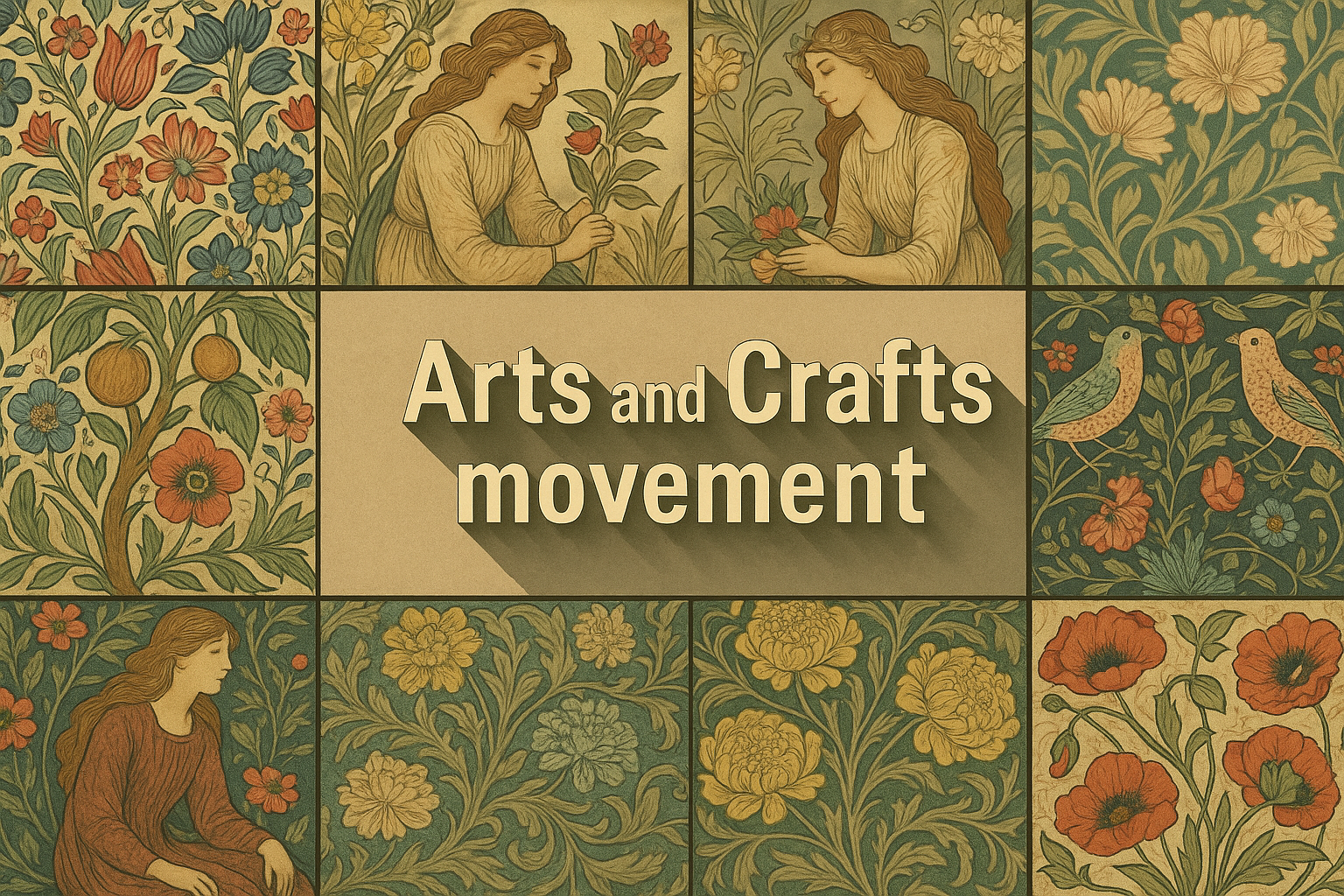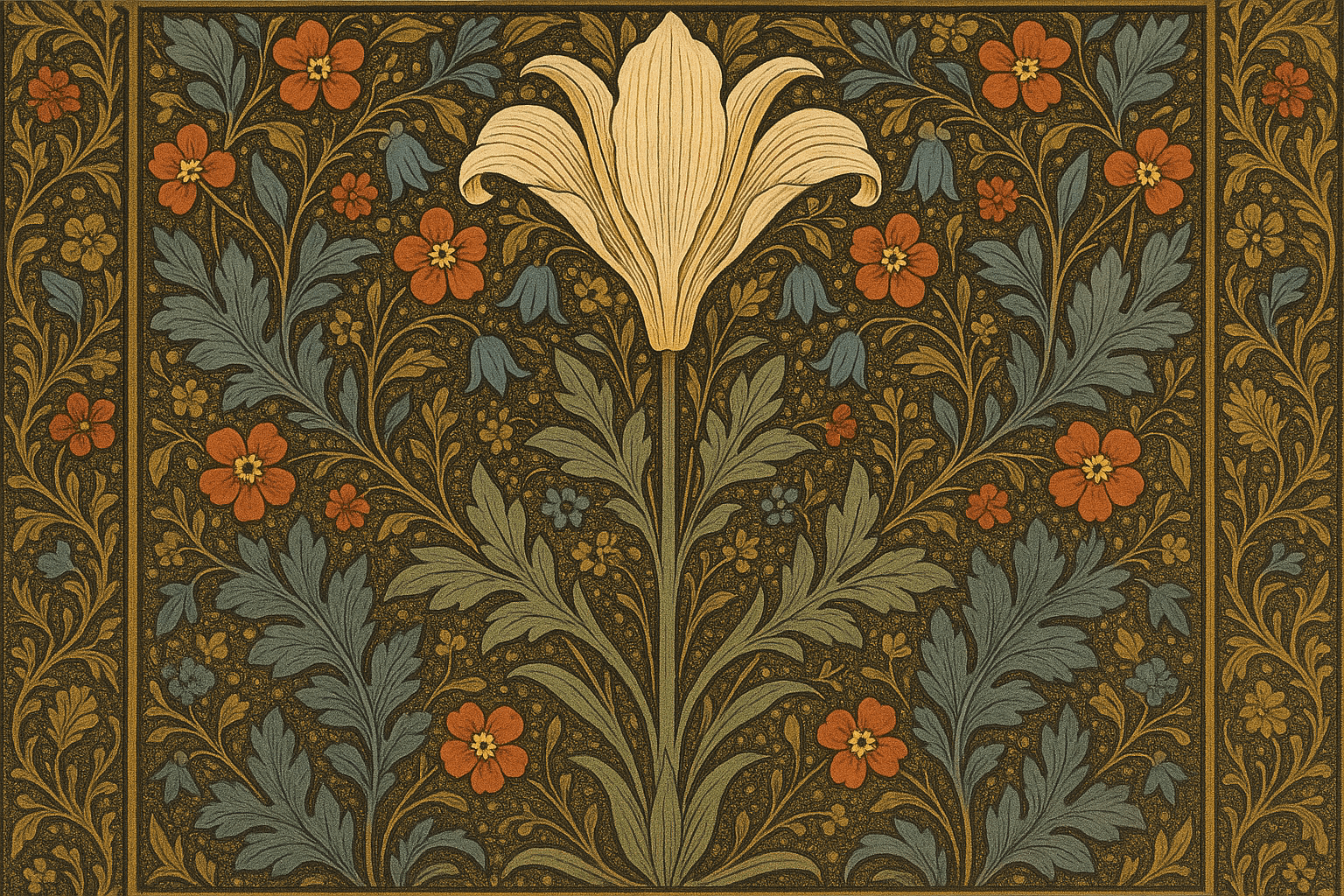
Arts and Crafts movement
The Arts and Crafts movement was a visual arts movement that began in Britain in the late 19th century and spread to the rest of Europe and North America. It was characterized by a return to traditional craftsmanship and an emphasis on simplicity and functionality.
AOI thinking about Arts and Crafts movement [+_~]-/
Overview and Quickfacts
The Arts and Crafts movement was a social and artistic movement that began in Britain in the late 19th century and spread to other countries, including the United States. The movement advocated for the reform of design and craftsmanship, and promoted the idea that art should be accessible to everyone. The Arts and Crafts movement was a reaction against the Industrial Revolution and the mass-produced, often poor-quality goods that it produced.
Can understand it also, as:
The Arts and Crafts movement was a social and artistic movement of the late 19th and early 20th centuries.
Categorize it as:
Impressionism, Modernism
.: Dreaming :.
holds a HAIKU for the art style
:. Thought is power .:
Detailed Description
The Arts and Crafts movement was an international movement in the decorative and fine arts that began in Britain and flourished in Europe and North America between about 1880 and 1920. It stood for traditional craftsmanship using simple forms, and often used medieval, romantic, or folk styles of decoration. It advocated economic and social reform and was anti-industrial. It had a strong influence on the arts in Europe until it was displaced by Modernism in the 1930s, and its influence continued among craft makers, designers, and town planners long afterwards. The Arts and Crafts movement began as a reaction against the mechanization of the Industrial Revolution and the mass production that followed it. The movement was rooted in a desire to revive the skill of handcraft and to return to a more simple and honest way of life. The Arts and Crafts movement was led by a group of English artists, architects, and designers including William Morris, John Ruskin, and Augustus Welby Pugin. These men were deeply influenced by the writings of the ancient Roman architect Vitruvius, who advocated the use of simple forms and natural materials in architecture. The Arts and Crafts movement spread to Europe and North America, where it had a profound impact on architecture, interior design, and the decorative arts. In America, the movement was particularly strong in the cities of Boston and Chicago. Some of the most famous artists associated with the Arts and Crafts movement include William Morris, Charles Rennie Mackintosh, and Frank Lloyd Wright. The Arts and Crafts movement was characterized by a return to simple forms and natural materials. Furniture was often made of oak or other woods, and upholstery was usually in muted colors. Walls were often painted in earth tones, and floors were often left bare. The style was often used in public buildings such as libraries and train stations, as well as in private homes. Famous examples of Arts and Crafts architecture include the Red House in England, designed by William Morris, and the Robie House in Chicago, designed by Frank Lloyd Wright. Famous examples of Arts and Crafts furniture include the Morris chair, designed by William Morris, and the Mackintosh chair, designed by Charles Rennie Mackintosh. Famous examples of Arts and Crafts textiles include the fabrics designed by William Morris for the firm of Liberty & Co. The Arts and Crafts movement had a profound impact on the way we live today. The simple forms and natural materials used in Arts and Crafts design are still popular, and the style continues to influence architects, interior designers, and craftspeople all over the world.
.. beep, beep, beep ..
<START OF TRANSMISSION>
1. The Arts and Crafts movement was an international movement in the decorative and fine arts that began in Britain and flourished in Europe and America between about 1880 and 1920. 2. It stood for traditional craftsmanship using simple forms, and often used medieval, romantic, or folk styles of decoration. 3. It advocated economic and social reform, and was originally inspired by the writings of John Ruskin. 4. The name "Arts and Crafts" was first used by the British critic and historian William Morris. 5. A central figure in the movement in Britain was the architect and designer Charles Rennie Mackintosh. 6. The Arts and Crafts movement emerged from the Aesthetic movement and the Anglo-Japanese style, and was also influenced by the work of the Pre-Raphaelites. 7. In America, the Arts and Crafts style is often associated with the work of Gustav Stickley and his Craftsman magazine. 8. The movement had a strong influence on the arts in Europe and America, as well as on architecture, painting, and crafts such as pottery, metalwork, and textiles. 9. It also had an impact on education, with the establishment of schools and colleges that taught crafts and design. 10. The Arts and Crafts movement was widely criticized for its lack of originality and for its imitation of historical styles. 11. It was also accused of being elitist and of promoting the interests of the middle class. 12. The movement declined in the early 20th century, but its influence can be seen in the work of later artists and designers, such as Frank Lloyd Wright and Le Corbusier. 13. The Arts and Crafts movement is sometimes referred to as the Second Industrial Revolution. 14. The first Arts and Crafts Exhibition was held in London in 1888. 15. The movement spread to America in the 1890s, and to Europe in the early 20th century. 16. In America, the Arts and Crafts style is often associated with the work of Gustav Stickley and his Craftsman magazine. 17. The movement had a strong influence on the arts in Europe and America, as well as on architecture, painting, and crafts such as pottery, metalwork, and textiles. 18. It also had an impact on education, with the establishment of schools and colleges that taught crafts and design. 19. The Arts and Crafts movement was widely criticized for its lack of originality and for its imitation of historical styles. 20. It was also accused of being elitist and of promoting the interests of the middle class.
<EOF>
.. robbel bob
Visual Examples from our image gallery
Coming soon, we are so slow .. might never come
Artists, Paintings, and more
(be aware, can be highly speculative)
Artists (be aware, speculation possible):
1. William Morris (1834-1896) 2. John Ruskin (1819-1900) 3. Dante Gabriel Rossetti (1828-1882) 4. Edward Burne-Jones (1833-1898) 5. Philip Webb (1831-1915) 6. Charles Robert Ashbee (1863-1942) 7. C.R. Ashbee 8. Ernest Gimson (1864-1919) 9. Sidney Barnsley (1863-1926) 10. Douglas Mackintosh (1868-1928) 11. Walter Crane (1845-1915) 12. T.C. Lethbridge (1864-1932) 13. W.R. Lethbridge 14. A.W.N. Pugin (1812-1852) 15. Owen Jones (1809-1874) 16. James Nasmyth (1808-1890) 17. Augustus Welby Pugin (1812-1852) 18. William Burges (1827-1881) 19. Richard Norman Shaw (1831-1912) 20. John Dibblee Crace (1809-1889) 21. William De Morgan (1839-1917) 22. Christopher Dresser (1834-1904) 23. George Frederick Bodley (1827-1907) 24. Henry Holiday (1839-1927) 25. William Morris, Jr. (1861-1934) 26. May Morris (1862-1938) 27. Charles Voysey (1857-1941) 28. M.H. Baillie Scott ( 1865-1945) 29. J.H. Dearle (1860-1932) 30. C.F.A. Voysey (1857-1941)
Artworks (be aware, speculation possible)
1. William Morris, “The Blue Bird”, 1874 2. Dante Gabriel Rossetti, “Beata Beatrix”, 1864-70 3. Edward Burne-Jones, “The Golden Stairs”, 1883 4. John Ruskin, “The Stones of Venice”, 1851-3 5. William Holman Hunt, “The Scapegoat”, 1854-5 6. John Everett Millais, “Ophelia”, 1851-2 7. Ford Madox Brown, “Work”, 1852-4 8. Augustus Welby Pugin, “Contrasts”, 1836 9. Philip Webb, “Red House”, Bexleyheath, Kent, 1859 10. William Morris, “The Defence of Guenevere”, 1858 11. Edward Burne-Jones, “The Briar Wood”, 1875-6 12. John Ruskin, “The Seven Lamps of Architecture”, 1849 13. William Morris, “The May Queen”, 1871-2 14. Dante Gabriel Rossetti, “Dante’s Dream”, 1865 15. Edward Burne-Jones, “The Sleep of Arthur in Avalon”, 1881-3 16. John Everett Millais, “Mariana”, 1851 17. Ford Madox Brown, “Cromwell”, 1852-3 18. Augustus Welby Pugin, “Gothic Revival”, 1843 19. Philip Webb, “The Grange”, Hertfordshire, 1859 20. William Morris, “The Woodspurge”, 1874-6 21. Edward Burne-Jones, “The Golden Stairs”, 1883 22. John Ruskin, “The Stones of Venice”, 1851-3 23. William Holman Hunt, “The Scapegoat”, 1854-5 24. John Everett Millais, “Ophelia”, 1851-2 25. Ford Madox Brown, “Work”, 1852-4 26. Augustus Welby Pugin, “Contrasts”, 1836 27. Philip Webb, “Red House”, Bexleyheath, Kent, 1859 28. William Morris, “The Defence of Guenevere”, 1858 29. Edward Burne-Jones, “The Briar Wood”, 1875-6 30. John Ruskin, “The Seven Lamps of Architecture”, 1849
Epoch
The Arts and Crafts movement was a period of time that lasted from approximately 1860 to 1910.
AI ART RESSOURCES (AKA, well Tools)
Helping tools -> predefined search links on other pages:











